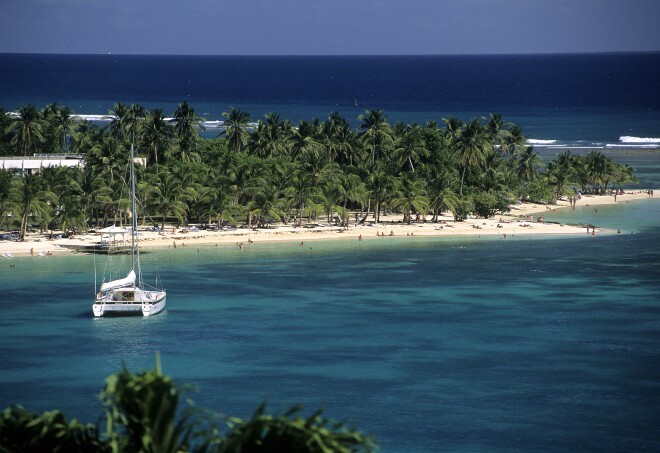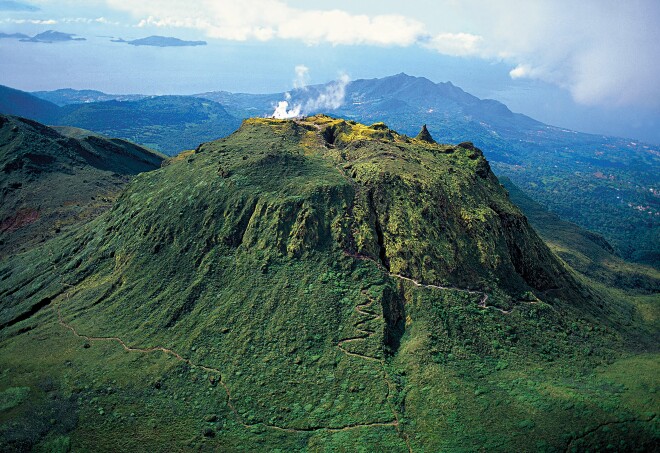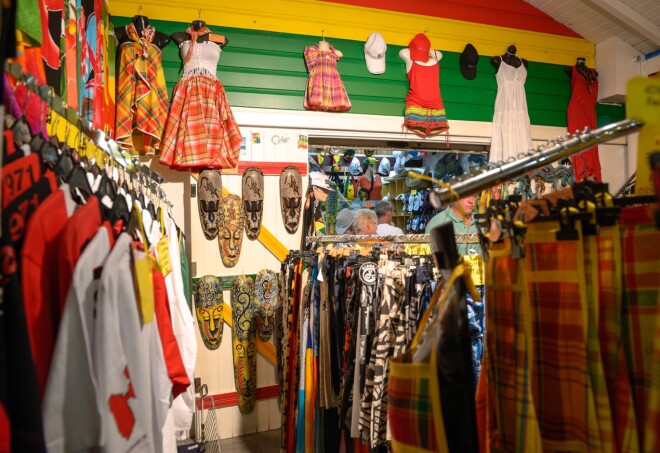Guadeloupe for Families
On Guadeloupe, keeping active with the family is a part of everyday life. Parents love to head outside and play with their kids. Many beaches are illuminated at night, so families can go for a swim, jog, or game of volleyball even after the adults have finished work. Guadeloupe National Park is everyone’s favorite outdoor playground, offering nature hikes, waterfalls, and thermal pools for all ages. The archipelago is, therefore, a great place for families to visit. And there’s also cultural learning in the form of botanical gardens, colorful markets, museums, and former plantations.
Délair 97180 Sainte-Anne, Sainte-Anne, Guadeloupe
Located in Sainte-Anne, Karukera Land is a recreational park that makes for a fun and self-contained outing for families. Learn about the island’s flora with a walk through the tropical gardens, and visit a range of Caribbean fauna, from goats to peacocks. Active kids will love the acrobatic course, trampolines, and swimming pools with multiple toboggan slides. There’s plenty to entertain grown-ups as well, including billiard and ping-pong tables, a mini-golf course, and spa relaxation area with massage hut.
One of the most popular beaches on Guadeloupe is Sainte-Anne, a family-friendly, mile-long stretch of white sand on the south coast of Grand-Terre. A coral reef protects the beach and the resulting calm water offers shallow swimming for the little ones. The beach has everything you need, including a fruit and spice market, casual beachfront restaurants, and a nearby arts and crafts shopping mall. After sunset, it is illuminated until midnight and active families come for a cool night swim, beach volleyball, and street snacks. Food trucks come out for the night, serving up bokits (a kind of fried sandwich) and conch kebabs.
Monteran, St Claude 97120, Guadeloupe
Covering nearly two thirds of Basse-Terre island, Guadeloupe National Park is an astounding 54,000 acres of lush rain forest, plus offshore mangrove and coral reefs. Some of the island’s best-known sights are inside the park, including active La Grande Soufrière volcano at its center, 4,800 feet above sea level. The park also contains famous waterfalls like Carbet Falls and the Cascade aux Ecrevisses, and Les Bains Jaunes thermal pool is a refreshing swim after conquering one the park’s many hiking trails. Nature lovers will swoon over the 800-plus species of flora and fauna here, ranging from orchids to bats to the endangered agouti (a type of small rodent). You can explore Guadeloupe National Park on your own or go with an outfitter like Vert Intense, an eco-friendly operation that knows every inch of this vast green escape, and also offers canyoning.
Malendure 97125, Bouillante, Guadeloupe
The black-sand Plage de Malendure on Basse-Terre is a water sports hub, home to dive shops that head out to the Jaques Cousteau Reserve. It’s a great spot to park the family for a day of swimming, snorkeling, or kayaking over to the Pigeon Islands. It’s busy and social, but that doesn’t take away from its beautiful bluff and sea views.
A favorite with Guadeloupeans, Plage de la Datcha in Gosier is busy with diners enjoying the beachfront restaurants and roadside snack stands, as well as snorkeling, swimming, or kayaking over to Gosier Islet, visible from shore. The vibe is ultra-local and lively, day or night. Throw your towel on the soft white sand, and make your stay as relaxed or active as you wish.
Guadeloupe
The most important historical site on Guadeloupe’s miniature archipelago of Les Saintes also boasts one of the most breathtaking views in the Caribbean. Perched some 400 feet above Les Saintes Bay, Fort Napoleon’s panoramic view of the water—dotted with sailboats and surrounded by bluffs—is worth a visit to Terre-de-Haut on its own. But it’s of historic interest as well. Rebuilt in the mid-19th century after the British destroyed it, the fort turned into a prison that was used during World War II. It was restored in the 1980s and houses a museum showcasing the history of Les Saintes. You can stroll inside to see the former grounds that served as a jail, and walk the botanical gardens afterwards, filled with the island’s various cactus species. Look out for iguanas peeking out of holes in the fort’s walls, as ubiquitous on the grounds as they are all over the island. Take in the glorious scenery for as long as you like before descending back down, on foot or on your rented electric scooter.
Îlet du Gosier, Guadalupa, Guadeloupe
After grabbing lunch on the ultra-local Plage de la Datcha on the south of Grande-Terre, hop on an afternoon boat shuttle from the beach to nearby Îlet du Gosier. You can spot the islet from shore—and if you’re fit, you can even kayak or swim over. With a wraparound white-sand beach, shallow waters for snorkeling, and the rustic Ti’ Robinson bar for rhum cocktails and Creole dishes, it’s the perfect day trip from somewhere like Pointe-a-Pitre.
Sainte-Anne, Guadeloupe
Conveniently located less than a five-minute walk from Sainte-Anne Beach, the Village Artisanal is a partially open-air, ground level strip mall lined with arts and crafts boutiques. Vibrant colors bounce off the walls from all the beachwear, sarongs, handcrafted jewelry, traditional madras clothing, and household items, as well as the rhum bottles and souvenir trinkets. There’s a small snack bar on-site where you can sit and take a break between shopping runs.
Bananier, Basse-Terre 97130 Guadeloupe
Le Rivage, specializing in Creole cuisine, is a charming place to stop for lunch on the way back from hiking Guadeloupe National Park. This casual, family-friendly establishment has a wood-floored dining room with shutters opening onto views of Bananier Beach, welcoming in a constant breeze. The local drinks are made to order. Pick your rhum of choice from the display table and sip on a ti’ punch before savoring typical plates like cod fritters, fresh lobster stuffed with spices, and goat stew.
Pointe Noire, Guadeloupe
Take a walk through the gardens at La Maison du Cacao and get a lesson on chocolate making, from the tree to the roasting to the production. Located in Pointe-Noire, an area where cacao once grew abundantly, Maison du Cacao offers tastings and an on-site shop where you can purchase their chocolate bars.
Rue Frébault, Pointe-à-Pitre, Guadeloupe
On the weekend, market days in Pointe-à-Pitre are like an outdoor celebration, with gwo-ka drumming on the streets leading to the markets. Browse the attractive stalls brimming with spice-filled bags at the Spice Market before checking out the arts and crafts and madras textiles and moving on to fruits and vegetables at Marché de la Darse on the waterfront. Take a break at a nearby café afterwards, and relax some more to the sound of the drums.
Guadeloupe
An archipelago within an archipelago is already an astonishing fact to grasp, but Îles des Saintes, made up of nine islets, only two of them inhabited, is full of yet more surprises. Hop on a daily ferry ride south from Trois-Rivieres in Basse-Terre to these gorgeous offshore islands around a stunning aquamarine bay dotted with sailboats and hugged by coral reefs. Also known as Les Saintes, these islands combine a traditional Caribbean setting of secluded beaches, forts, and towering palm trees with a chic French village lifestyle. The streets here are free of cars, the winding roads to be explored by electric scooter or on foot. Hike to Fort Napoleon for a breathtaking panoramic view over Les Saintes Bay, explore the surrounding waters by catamaran, go diving off the bluffs, sample some of Guadeloupe’s best French and Creole fusion restaurants, and shop the boutiques for French fashions and local jewelry.
Locals agree that Marie-Galante is the “real” Guadeloupe. Daily ferries whisk visitors and residents back and forth to this island, 40 minutes south of Grande-Terre across occasionally choppy waters. But the charming, pastoral island is well worth it. On Marie-Galante, more farmers ride ox-drawn carts than buses, and the most uncrowded, pristine beaches line the turquoise waters here—like the secluded and brilliant white Plage Vieux Fort. The food is traditional Creole, served with pride in homes-turned-dining-rooms, while the rhum distilleries are considered the best in Guadeloupe.






















